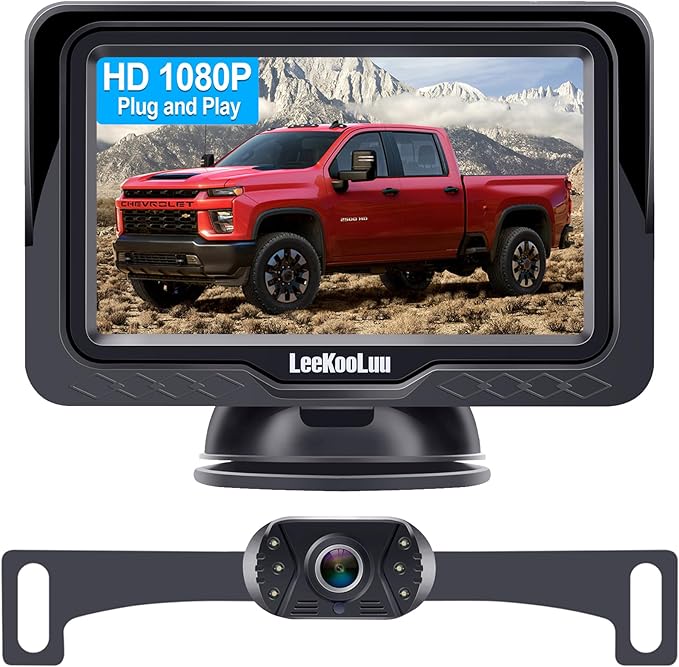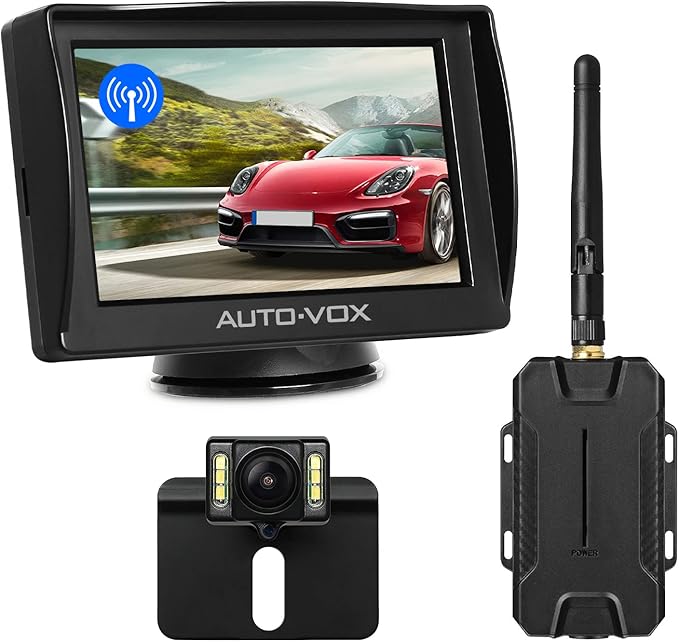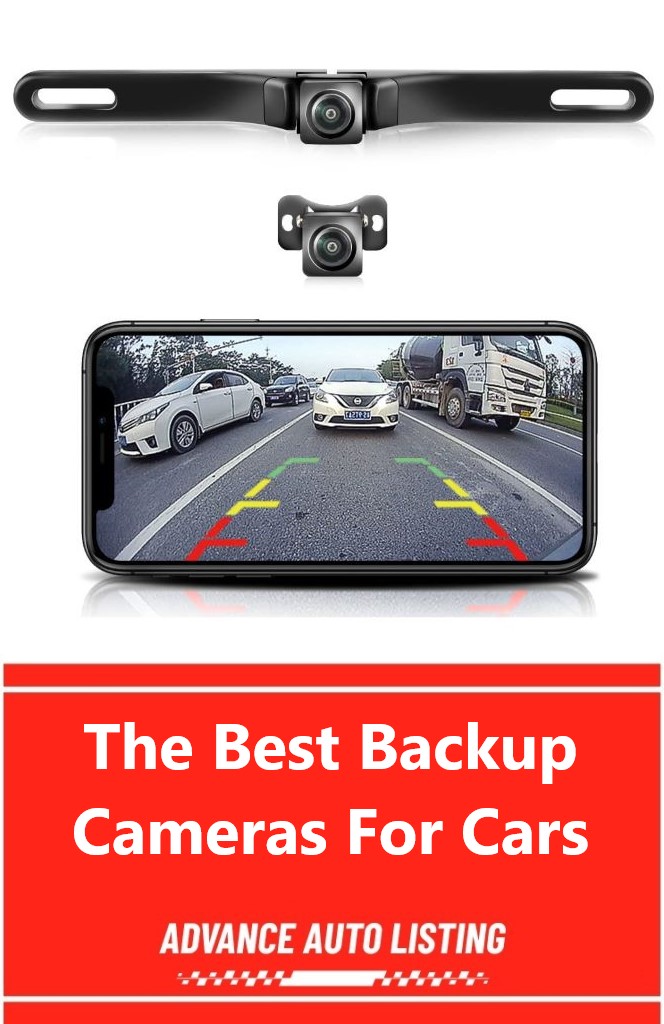Modern rearview camera systems have been shown to reduce back-up accidents by as much as 57%, especially when hooked up with the car’s audible near-collision sensors. And with NHTSA’s rear visibility regulations already in effect as of 2014, you really need to start thinking about upgrading your car’s rear visibility capabilities. We came up with a list of the best backup cameras for cars to get you started.
Best Rated Backup Cameras For Cars
1. ZEROXCLUB Digital Backup Camera System Kit

With a 7-inch LCD monitor providing you an excellent view of what is going on in the rear of your vehicle, the ZEROXCLUB makes its way as one of the top backup cameras for cars, or more specifically, for larger vehicles like RVs, trailers, 5th wheel, and many more.
The LCD monitor may not have 1080p resolution, but its intelligent CMOS sensor coupled with infrared lighting should give you crystal clear images from the rear of the vehicle. The camera system is also rated IP69K, perfect for the grueling roads that large vehicles have to go through. The wireless transmitter won’t interfere with the other wireless systems in your rig, giving you absolute control behind the wheel and an increased feeling of safety and security as you drive along the highways and byways of the country.
The ZERXCLUB wireless backup camera may not be for every motorist on the road, but it sure is one of the best, especially for those who really require some assistance backing up an extra-long and extra-large vehicle.
2. PRUVEEO D700 7-Inch Touch Screen Backup Camera

If you’re already accustomed to using your rearview mirror that you think it’s virtually impossible to replace it as your principal assistive device when parking backwards, then the PRUVEEO should really interest you. Unlike other car reverse camera systems that utilize the rearview mirror, this baby comes with a full 7-inch TFT display.
The camera up front records in stunning 1080p while the rear shooter comes in at VGA resolution. Still, with the cameras wired directly to the large screen, your safety while driving has just been increased immensely. It’s easy to install and comes with loop recording capabilities.
3. Z-EDGE S3 Dual Dash Cam

Most reverse camera systems come with mediocre-quality videos that remind you of legacy television sets – grainy at best. This backup dash camera system from Z-EDGE comes with a whopping 2560 x 1440 resolution up front and a not-so-bad 1920 x 1080 HD at the rear. Of course, if you let them record simultaneously, you’ll be left with the 1080 version.
Still, it’s much better than the other systems in the market. The system can also be hardwired to your ignition system, turning itself on and off automatically. The only downside is that its LCD display only comes in at a mediocre 2.4-inch. It’s like looking at the screen of a legacy bar phone. Nevertheless, the clarity of the images is simply one of the best.
4. AUTO-VOX T2 Backup Camera Kit

Unlike some aftermarket backup camera systems, this car backup camera from AUTO-VOX prides itself on an easy single-wire installation that can get you up and running within minutes. It’s as easy as attaching the rear camera bracket to your rear license plate and connecting the wire to your reverse light.
There are also parking assist grid lines on its 4.3-inch screen that is embedded into the nifty and elegantly designed rearview mirror. Its 170-degree viewing angle is one of the best we’ve seen in the market. It’s the perfect solution for those who clearly don’t like to have a headache just installing a backup camera in their cars.
5. LeeKooLuu Backup Camera and Monitor Kit

Feel a lot safer behind the wheel with a 4.3-inch screen on your dashboard providing high-quality images of your car’s rear. This car backup camera kit may not really have the best-looking images that you’re looking for, but with exceptional weatherproofing, ease of installation, and night vision capabilities you’d really be thankful that it has one of the friendliest price tags in the market. As such, you don’t need to spend several hundreds of dollars since you’ve got a basic system that works.
6. AUTO-VOX M1W Wireless Backup Camera Kit

The M1W wireless backup camera system is great for those who require an easy-to-set-up system that doesn’t require too many wires to connect one device to another. The wireless transmitter on the M1W is designed so it doesn’t interfere with other devices that use wireless technology so you’ll still retain the full functionality of these devices even when the M1W is in operation.
The 4.3-inch LCD also comes with a hood to help minimize glare and improve viewing angles on the screen. The camera at the back is small enough never to detract from the aesthetics of your car. Given its modest specs, we’re actually surprised that it actually costs more than twice the price of similar systems.
7. Chuanganzhuo Backup Camera and Monitor Kit

If you’re on the lookout for a really inexpensive aftermarket backup camera to help you reduce accidents during reverse driving, then a good solution is the Chuanganzhuo system. This license plate-mounted backup camera already comes with everything you need to get the job done, including a 4.3-inch LCD that can have either a 4:3 or 16:9 aspect ratio. For its price, don’t expect to get full HD quality, though as it only comes in the standard VGA resolution of 480 x 272.
Nevertheless, this baby is fully expandable and capable of supporting a multitude of video devices including DVD, satellite receiver, and many more. The infrared night vision capability is passable while its distance scale grid on the screen is a welcome addition.
8. iStrong Backup Camera and Monitor Kit

From the price to the design and right down to the spec sheet, the iStrong car reverse camera system is definitely identical to the Chuanganzhuo kit. That being said, you can actually choose either of the two especially if your main consideration is the price. There really isn’t much to differentiate these two products, leading us to think that they may come from only one manufacturer but are distributed by two different entities.
Whatever the case, you get the same features as the Chuanganzhuo. Perhaps the only difference is that the latter comes with only a 1-year warranty while iStrong gives you 2 years.
Things to Consider When Buying Backup Cameras for Cars
Buying the best backup camera for your car can be very rewarding especially if you did a good job in looking for the most appropriate system for your car. To help you zero in on your dream system, here are some variables you need to consider.
Sensor
There are two image sensors currently used in rear-view camera systems today. CCD sensors provide the best image quality even in low light conditions.

The downside is that they are naturally more expensive. On the other hand, CMOS sensors can still provide good-quality videos if they have adequate LED lighting built-in.
Parking lines
These are virtual grid lines found on the LCD monitor and help guide the driver in the reverse driving process. These provide an idea of the distance of your vehicle relative to other structures and objects at the back. It also shows the direction of the maneuver so that the driver can make the necessary corrections.
Viewing angle
The NHTSA requires that all vehicles should have rearview imaging technology that can show a 10×20-foot area in the rear of the vehicle. As such, the viewing angle of the camera system is a very important consideration. You should always go for a higher viewing angle such as 150 to 170 degrees.
Low light visibility
Backing up in low light conditions can be nerve-wracking simply because the reduced visibility increases the risk of hitting something while driving in reverse. This is where low-light visibility technologies can come in. As much as possible, infrared light mechanisms should be built into the system to allow for greater clarity of images even at night, although CCD sensors can do exceptionally well.
Mounting
This actually spells ease of installation. Some can be easily mounted onto the frame of license plates while others require a few small holes to be drilled to mount a bracket. Others can also be clipped onto the lip of the license plate.
Waterproof rating
Most car backup systems come with a rating of IP68 which means they can withstand up to 1.5 meters of submersion in addition to dirt, dust, and sand resistance. IP69K-rated devices are the best since the rating is highly specific to heavy-duty applications.
Benefits of Using Backup Cameras for Cars
The NHTSA says that reverse backup cameras can help reduce accidents by up to 57%. This more than summarizes the many benefits of using such systems in our vehicles. Here are a few more.
Eliminates blind spots
Most systems provide at least a 120-degree field of view of the rear of our vehicles. Some systems even come with 170 degrees. Traditional rearview mirrors can only show so much of the rear that you’ll even need to turn your head all the way backward to help you drive in reverse. With camera backup systems, you no longer have to turn your body backward as everything is already on your monitor. Plus, there are parking grid lines to guide you in your driving backward.
Facilitates safe parking in reverse
As we already mentioned car backup camera systems already come with parking guides so it is all a matter of maneuvering your car to follow these virtual lines. There are also specific zones in the grid that tell you if you’re already too close to a particular structure.
Allows for fine-tuning reverses in heavy traffic
Getting stuck in traffic is never pleasant. Sometimes you just want to drive in the other lane just to get out of the gridlock. Unfortunately, backing up to mere inches from the front bumper of another vehicle can be nerve-wracking. This is never a problem with a reverse camera system onboard.
Keeps vehicle occupants safe
Existing literature points to the usefulness of rear-view camera systems in avoiding unnecessary collisions emanating from driving in reverse. This can help protect the occupants of the vehicle whether it is your family, your kids, or even your pets in the passenger seat.

Types of Backup Cameras for Cars
One of the considerations you’ll have to make when choosing a backup camera for your car is the type of unit you want to install. Here are the 3 fundamental types of backup cameras for cars.
Surface-mounted
These are typically found in larger vehicles like trucks, trailers, RVs, and 5th wheel, among others. These can be easily mounted high to provide a commanding view of the rear and beyond while also giving exceptional depth perception.
Flush-mounted
These are perfect for car owners who would like to install relatively discreet reverse camera systems in their vehicles. A hole is drilled in the rear panel of the car’s body and only the lens and its bezel are clearly visible on the outside. It provides a really nice clean look. The problem is that the camera is often in level with the ground surface so depth perception is not really that great.
License-mounted
These are the easiest to install as they can be easily mounted onto the rear license plate. Depth perception depends on the location of the plate. If it is closer to the road surface, then you have less depth perception. If it is located high up in the trunk, then you’ll have a better view of the rear.
FAQs
Q: How does a backup camera work?
Backup camera systems are not really new. In fact, the very first car reverse camera was introduced in the 1956 concept car Buick Centurion. The setup was simple. A television camera was installed in the rear of the Centurion and then wired to a television screen on a panel in the dashboard. The Centurion didn’t have rearview mirrors and instead used the camera system to allow the driver to back the vehicle up. Today, the same principle underscores the fundamental process upon which reverse camera systems operate. A camera is installed at the rear of the vehicle. The video is sent to a monitor on the driver’s section of the vehicle. The video is sent either by wires or by radio signals. The video camera is typically connected to the reverse light of the car. As soon as the shift lever is placed into the reverse position, it instantly activates the camera to present the video on the monitor up front.
Q: How to install a backup camera?
Installing a backup camera is quite easy as manufacturers already come with their own documentation on how you can install such units into your vehicle. Wireless systems offer exceptional ease of installation as there are no wires to run across the length of your car from the rear to the dashboard. One simply needs to mount the rearview camera, usually on the rear license plate of your vehicle. You may have to drill a hole in the mounting area to run the camera’s video and power cords through. Connect the camera power connector to the reverse light wires of your car. The wireless transmitter will also have to be connected. Once you’re done, you can easily mount the monitor either on your rearview mirror, your dashboard, or even your windshield. The monitor comes with a transceiver that communicates with the wireless transmitter. If your system is wired or corded, then you will have to run the video wire all the way from the rear to the dashboard. You have to be creative where you want to hide the wire since it really isn’t pleasant to look at. You then connect this to the monitor up front.
Q: Can I use it as a race car camera to see other cars behind me at high speeds?
Technically, you can use a backup camera in a race car. However, it doesn’t necessarily mean you should. In-car camera systems have been in select NASCAR race cars since 1983, offering the public a view of the track from inside the car. Sadly, the images made spectators dizzy. And while tremendous improvements in video quality have been made since then, the high-speed nature of racing also means you have plenty of road vibrations to think about. These vibrations can still lead to choppy and dizzying video feed from the rear camera. As race car drivers need to focus on the racetrack ahead of them, they only glance at their rearview mirrors in a split second. Even if you have the most sophisticated rearview camera, you wouldn’t really use it very often.
Q: Can I turn off the screen while driving?
Car backup camera systems automatically turn on when it senses that the reverse lights have been activated. Some rearview camera systems continue rolling even while the vehicle is moving. Many devices today come with a switch on the monitor that turns off the screen if you don’t really need it.
Q: Are backup cameras compatible with any vehicle?
The good thing about today’s car backup camera systems is that you can install it on any vehicle especially those built before 2014. This is because starting in 2018 all car manufacturers should already have these systems built into every car that rolls out of the assembly line. As long as your car has a reverse or backup light, then you could easily install an aftermarket backup camera.
Q: Can I hook up to my screen that’s already built in my car?
It depends on whether the system you’re using is the plug-and-play type or one that requires tapping into your car’s original circuitry. You need to check if your car’s existing video platform supports the video coming from the camera system. You may also need to determine if you have to program the camera to be accepted by your car. Technically, it is possible to hook up an aftermarket backup camera to your current video screen provided the two devices are compatible.
Our Top Pick
It may be priced higher than most systems we’ve viewed, but given the fact that the ZEROXCLUB Digital Wireless Backup Camera System comes with a 7-inch LCD monitor, an intelligent CMOS sensor, and remarkable wireless signal stability that ensures the best reception from the rearview camera it simply is our runaway pick for the best backup cameras for cars.
Sure, the quality of the video is not HD, but if you can get a much better view of your vehicle’s rear and everything else that is going on in the back you’d definitely want the ZEROXCLUB for your vehicle, too. Its IP69K rating is many times better than IP67 or IP68 rated systems, meaning it doesn’t matter if it gets blasted by a spray of water frequently as its rating is for heavy-duty applications. Now, top that!
Backup cameras for cars can help ensure safety while driving in reverse. And as federal regulations dictate that all cars manufactured beginning in 2018 should already have built-in reverse camera systems, you don’t have to punish yourself if your car still doesn’t have such a technology in place. You can start by choosing any of the best backup cameras for cars we’ve listed here and you’ll be on your way to a safer driving experience.


